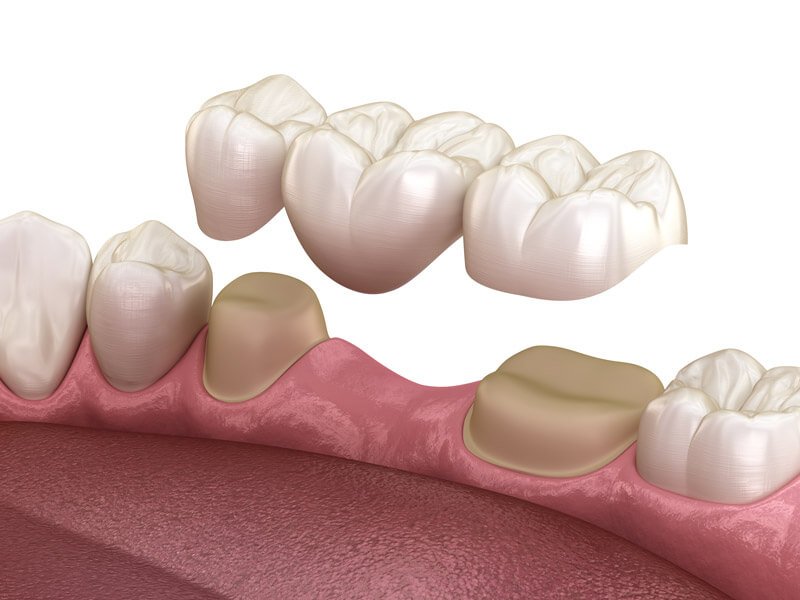Dental Bridge Central Coast
Dental Bridge Central Coast
If you are missing any teeth, you may have discussed missing tooth options with your dentist. Missing tooth options are simply an implant, bridge, denture or nothing. Few individuals will opt to do nothing when the missing tooth is visible or compromising chewing. Amongst these treatment options there are numerous variations.
A dental bridge can be used to replace one or more missing teeth. A traditional bridge consists of a crown(s) and a pontic(s), whereas a Merryland bridge consists of a pontic and two metal attachments called wings. The pontic is an artificial tooth that fills in the missing space(s) and is physically joined to the crown(s). The crown(s) are cemented in place so this is considered a fixed option.
The cost of a standard three unit bridge is close to that of an implant, yet it places additional strain on the surrounding teeth and has potential for compromising these teeth. For these reasons it is a secondary option to an implant for individuals looking to have a fixed option.

Dental Bridge Types
A bridge can be tooth supported or implant supported. The number of teeth or ‘units’ can range from two to a full arch. Two unit bridges are called cantilever bridges where a strong tooth such as a canine or a first molar is crowned and a smaller pontic is attached. In some circumstances, a Merryland bridge is used and this type of bridge does not require crown preparation of the adjacent teeth, and rather metal inserts are cemented to the back surface of the teeth.
Dental Bridge Materials
Materials are less limited for bridges than they are for crowns as they require considerable strength. The main materials are porcelain fused to metal or zirconia. Any other all-ceramic material is simply too weak.
If you are missing any teeth, you may have discussed missing tooth options with your dentist. Missing tooth options are simply an implant, bridge, denture or nothing. Few individuals will opt to do nothing when the missing tooth is visible or compromising chewing. Amongst these treatment options there are numerous variations.
A dental bridge can be used to replace one or more missing teeth. A traditional bridge consists of a crown(s) and a pontic(s), whereas a Merryland bridge consists of a pontic and two metal attachments called wings. The pontic is an artificial tooth that fills in the missing space(s) and is physically joined to the crown(s). The crown(s) are cemented in place so this is considered a fixed option.
The cost of a standard three unit bridge is close to that of an implant, yet it places additional strain on the surrounding teeth and has potential for compromising these teeth. For these reasons it is a secondary option to an implant for individuals looking to have a fixed option.

Dental Bridge Types
A bridge can be tooth supported or implant supported. The number of teeth or ‘units’ can range from two to a full arch. Two unit bridges are called cantilever bridges where a strong tooth such as a canine or a first molar is crowned and a smaller pontic is attached. In some circumstances, a Merryland bridge is used and this type of bridge does not require crown preparation of the adjacent teeth, and rather metal inserts are cemented to the back surface of the teeth.
Dental Bridge Materials
Materials are less limited for bridges than they are for crowns as they require considerable strength. The main materials are porcelain fused to metal or zirconia. Any other all-ceramic material is simply too weak.
Is a dental bridge right for me?
At Element Dental, assessment begins with an open discussion on suitable missing tooth options. We believe each individual needs to be provided with a thorough assessment to be able to make an informed decision. Not everyone is suited to an implant, not everyone is suited to a denture, and not everyone is suited to a bridge. It is critical to identify suitability for long-term success of your investment.
To deem a bridge as suitable the health of the region is assessed including periodontal health, bone levels, mobility, and strength of supporting teeth.
How do I care for my Dental Bridge?
Bridges typically require extra care as they do not allow for the easy insertion of floss. We provide education using a modified floss technique on the day of bridge cementation. This technique uses Superfloss (threader floss). The Waterpik Water Flosser Ultra and/or Piksters may also be recommended. It is recommended to have routine exam and clean appointments to monitor the bridge.
If you are looking for a dental bridge on the Central Coast, or would like to simply know more about your missing teeth options on the Central Coast, book your consultation appointment today.